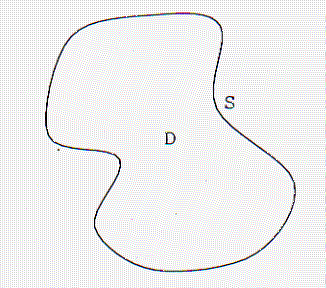3.5 Test problem - the interior Laplace problem
The interior Laplace problem involves the solution of the Laplace
equation in a domain that is bounded by a closed surface in 3D
or a closed boundary in 2D. An illustration of the problem
is shown in figure 3.2.
 Figure 3.2. An Illustration of the Laplace Problem.
Figure 3.2. An Illustration of the Laplace Problem.
3.5.1 Matrix Equivalent of the Operators
Applying collocation to generally requires that the closed boundary S is
replaced by an approximate boundary S' made up of a set
of n elements DS'j (j = 1,..,n) in the way described in
Chapter 2. Let the points
pj (j = 1,..,n) with pj Î
D
S'j be the collocation
points. In this work we consider only the approximation of the
boundary functions by a constant on each elment.
It is helpful to adopt the following notation:
|
[ L ]ij = { L |
e'
|
}DS'j(pi) , |
| (34) |
|
[ Mk ]ij = { M |
e'
|
}DS'j(pi) , |
| (35) |
|
[ Mkt ]ij = { Mt |
e'
|
}DS'j(pi; npi) , |
| (36) |
|
[ Nk ]ij = { N |
e'
|
}DS'j(pi ;
npi) , |
| (37) |
where npi is the unit outward normal to S' at pi.
This gives the four n ×n matrices
Lk, Mk, Mkt and Nk.
The approximate boundary functions can be approximated by a vector
|
m = [ |
m'
|
(p1),..., |
m'
|
(pn) ]T. |
|
3.5.2 The Linear System
The application of collocation to the above equation give the
following linear systems of approximations
where vj = v(pj) for j = 1,...,n. Hence the primary stage of the
boundary element method entails the solution of the following linear system
of equations:
|
( Mk - |
1
2
|
I ) |
^
f
|
= aLk v |
| (39) |
which yields an approximations to f(pj),
for j = 1,...,n.
The secondary stage of the boundary element method requires the calculation
of the approximation to f(p) where p is a point in the
approximate exterior domain E.
For this the discrete forms are substituted into
(3) to give
|
|
^
f
|
(p) = |
n
å
j = 1
|
[ { M |
e'
|
}DS'j(p) |
^
f
|
j -{ L |
e'
|
}DS'j(p) vj] (p
Î |
E'
|
). |
| (40) |
Note that the secondary stage requires the evaluation of only
two integral operators in contrast with the primary stage which requires
all four. Note also that the special evaluation techniques
of subtracting out the singularity are required only for the
diagonal components of the matrices in (34), (37). This latter point is
a typical property of integral equation methods, the outcome of which
is that the generally greater cost of evaluating the discrete forms
when p lies on the element is not important when
assessing the overall computational cost.
Return to boundary-element-method.com/laplace
Return to boundary-element-method.com

